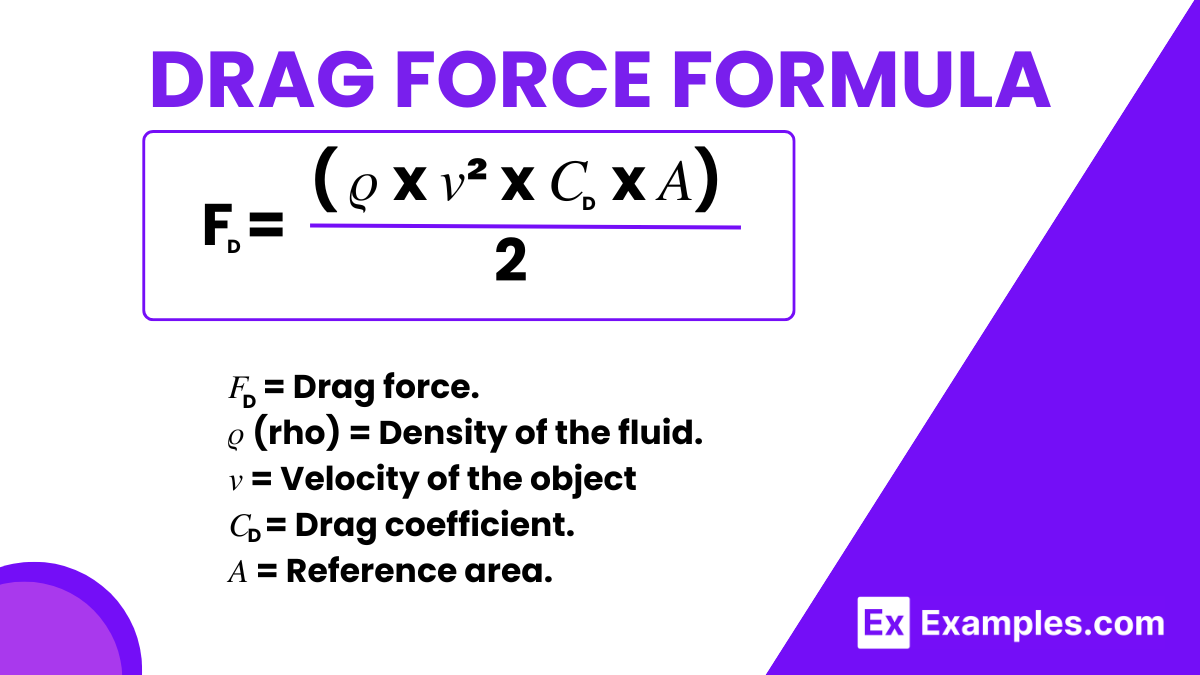How does the drag force change if the velocity of the object is doubled?
It remains the same
It doubles
It quadruples
It halves


The drag force formula is a fundamental equation in physics that quantifies the resistance experienced by an object as it moves through a fluid, such as air or water. The formula was derived from principles laid down by Sir George Stokes in the mid-19th century, although the concept of drag itself was studied by earlier scientists like Leonardo da Vinci. The drag force formula is crucial for calculating how much force opposes an object’s motion, affecting everything from the design of aircraft to the speed of swimmers. The formula is represented as :
This formula enables engineers and scientists to predict how much drag an object will experience under different conditions, which is vital for optimizing performance and efficiency in a variety of fields within physics. By adjusting parameters like shape (to alter 𝐶ₔ) or size (to alter 𝐴), designers can influence how an object interacts with its fluid environment.
Question: A car is traveling at a speed of 27 m/s (about 60 mph) through air with a density of 1.225 kg/m³. The frontal area of the car is 2.2 m², and its drag coefficient is 0.3. Calculate the drag force acting on the car.
Solution: Use the drag force formula: 𝐹ₔ = ( 𝜌 x 𝑣² x 𝐶ₔ x 𝐴 ) / 2
Plug in the values: 𝐹𝐷=( 1.225 × (27)² × 0.3 × 2.2 ) / 2
𝐹𝐷 ≈ ( 1.225 × 729 × 0.3 × 2.2 ) / 2
𝐹𝐷≈183.36525 N
Thus, the drag force on the car is approximately 183.37 newtons.
Question: A skydiver with a frontal area of 0.7 m² and a drag coefficient of 1.0 falls through the air (density = 1.2 kg/m³). What velocity must the skydiver reach for the drag force to be 800 N?
Solution: Rearrange the formula to solve for velocity 𝑣v: 𝐹ₔ = (𝜌 x 𝑣² x 𝐶ₔ x 𝐴) / 2
800 = ( 1.2 × 𝑣² × 1.0 × 0.7 ) / 2
800=0.42×𝑣²
𝑣² =8000.42
𝑣 ≈ √1904.76
𝑣≈43.64 m/s
Therefore, the skydiver must reach a velocity of about 43.64 m/s to experience a drag force of 800 newtons.
Question: If the frontal area of a bicycle and rider is increased by 50% from 0.5 m² to 0.75 m² while traveling at 12 m/s, and the drag coefficient remains constant at 0.9 with air density at 1.225 kg/m³, calculate the new drag force.
Solution: Calculate the initial drag force with the original area:
𝐹𝐷 = (1.225 × (12)² × 0.9 × 0.5 ) / 2
𝐹𝐷 = ( 1.225 × 144 × 0.9 × 0.5 ) / 2
𝐹𝐷=39.78 N
Now calculate with the increased area:
𝐹𝐷 = ( 1.225 × (12)² × 0.9 × 0.75 ) / 2
𝐹𝐷=59.67 N
Thus, with an increased area, the new drag force is approximately 59.67 newtons, showing how sensitive drag force is to changes in area.
Use the drag force formula: 𝐹D = ( 𝜌 x 𝑣² x 𝐶𝐷 x A ) / 2. By substituting values for air density (𝜌), velocity (𝑣), drag coefficient (𝐶D), and area (𝐴).
For lift: 𝐿 = ( 𝜌 x 𝑣² x 𝐶𝐿 x 𝐴 ) / 2. For drag: 𝐷 = ( 𝜌 x 𝑣² x 𝐶𝐷 x A ) / 2. 𝐶𝐿 is the lift coefficient.
Drag isn’t directly calculated from weight. It depends on velocity, fluid density, drag coefficient, and object area. By using 𝐹𝐷 = ( 𝜌 x 𝑣² x 𝐶𝐷 x 𝐴 ) / 2.
Text prompt
Add Tone
10 Examples of Public speaking
20 Examples of Gas lighting
How does the drag force change if the velocity of the object is doubled?
It remains the same
It doubles
It quadruples
It halves
In the context of the drag force formula, what does ρ represent?
Drag coefficient
Fluid density
Velocity
Reference area
What is the general formula for drag force?
Fd = 0.5 * Cd * ρ * A * v²
Fd = m * g
Fd = k * x
Fd = ρ * V * g
In the drag force formula, what does Cd represent?
Drag force
Fluid density
Drag coefficient
Velocity
What is the unit of the drag force (Fd) in the SI system?
Newton (N)
Pascal (Pa)
Joule (J)
Watt (W)
Which factor does not affect the drag force according to the formula Fd = 0.5 * Cd * ρ * A * v²?
Velocity of the object
Fluid density
Acceleration due to gravity
Reference area
How does the drag force change if the velocity of the object is doubled?
It remains the same
It doubles
It quadruples
It halves
In the context of the drag force formula, what does ρ represent?
Drag coefficient
Fluid density
Velocity
Reference area
If the reference area (A) is increased, what happens to the drag force?
It decreases
It remains the same
It increases
It becomes zero
What role does the reference area (A) play in the drag force formula?
It determines the mass of the object
It affects the velocity of the object
It represents the projected area perpendicular to the flow direction
It is unrelated to drag force
Before you leave, take our quick quiz to enhance your learning!

